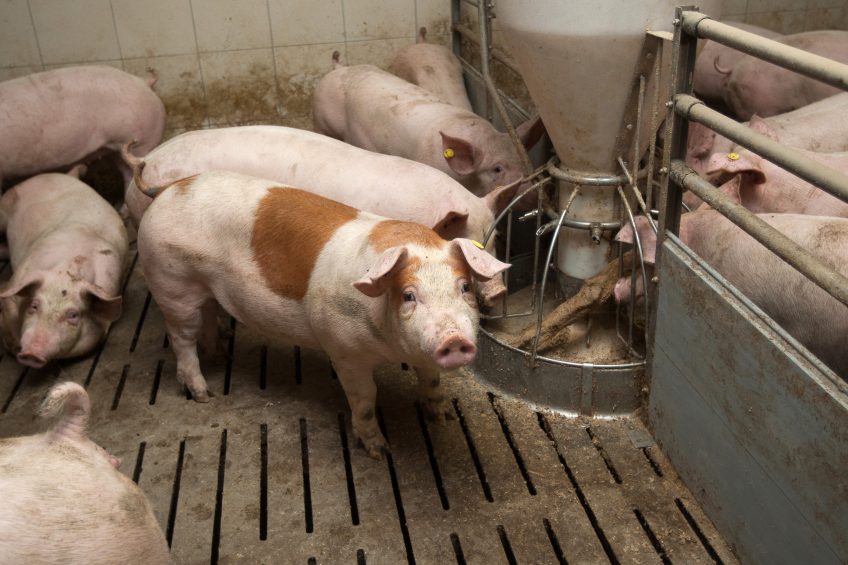Supporting fat digestion in weaned piglets

Modern animal production requires pigs to grow fast and for that reason, energy dense diets are formulated. Oils as well as fat-rich ingredients are used to achieve a high energy content in the feed. Fat digestion, however, is not optimal in piglets after weaning. Lysolecithins are a solution to support fat digestion in weaned piglets.
It is generally accepted that pigs will grow faster when they are heavier at the time of entering the finishing house. As a rule of thumb, for each kg higher body weight at the start of the finishing period, that phase is shortened by one week. This will save one week of feeding costs, which makes it even more interesting to stimulate optimal growth directly after weaning when feed intake is relatively low and thus less expensive.
Limited fat digestion in weaned piglets
Often, weaned piglets are provided with an energy-dense diet, including high amounts of oils and being rich in fat ingredients. That, however, does not always result in the optimal growth that is aimed for. That can be explained by the fact that fat digestion is limited in weaned piglets, because these animals do not produce sufficient amounts of bile phospholipids for an efficient emulsification.
Moreover, several studies have shown that levels of pancreatic lipase are low in weaned piglets. Although pancreatic lipase activity increases with age, a dramatic drop in activity is observed at the moment of weaning. Digestive problems may occur as a consequence of the poor emulsification and low pancreatic lipase activity which results in suppressed growth. Hydrolysed lecithins resolve these problems as these molecules are known to enhance the oil-in-water emulsification process, stimulate enzymatic fat digestion by lipase and even improve general nutrient transport and absorption.
Native versus hydrolysed lecithins
Lecithin is a complex mixture of phospholipids, some oil, glycolipids and carbohydrates. Lecithins are naturally occurring in plant and animal tissues. The phospholipids in lecithins have an amphiphilic character, meaning the molecule has both hydrophobic and hydrophilic characteristics.
This can be explained by the molecular structure, which consists of 2 hydrophobic fatty acid tails and a hydrophilic phosphate head, joined together by a glycerol molecule. The phosphate groups can be modified with simple organic molecules such as choline, ethanolamine or inositol forming phosphatidylcholine, phosphatidylethanolamine and phosphatidylinositol respectively. These so called native lecithins are byproducts from the oil refinery and usually applied in animal feed as a relatively cheap energy source.
In contrast, lysophospholipids, also known as lysolecithins, are better known for their strong capacities of promoting an oil-in-water emulsification. These lysolecithins are obtained by hydrolysis of a native lecithin by the action of the enzyme phospholipase A2 (see Figure 1). The hydrophobic fatty acid at the C2 position of the glycerol molecule is removed by the action of this enzyme. The obtained lysolecithins have a more hydrophilic character and a higher hydrophilic-lipophilic balance (HLB) than native lecithins, which explains their increased capacity to promote an oil-in-water emulsification.
Figure 1 – The formation of a lysophospholipid (lysolecithin). As an example the formation of lysophosphatidylcholine from phosphatodylcholine is shown.

How lysolecithins support fat digestion
For maximal utilisation of dietary fat in weaned piglets, all 3 stages of fat digestion should be considered:
- In the first stage of fat digestion, fat is emulsified by the action of bile salts. As fat is insoluble in water, fat droplets will accumulate into bigger fat globules in the aqueous environment of the small intestine. Lysolecithins promote an oil-in-water emulsion and are able to emulsify large lipid globules into small lipid droplets.
- As the contact surface of the fat globules is increased by reducing the fat globule size by the action of lysolecithins, more fat is exposed to lipase and thus more fat can by hydrolysed. The fat molecule, a triglyceride, is broken down by the action of lipase into 2 free fatty acids and 1 sn2-monoglyceride.
- After hydrolysis, mixed micelles with fatty acids, sn2-monoglycerides, bile salts and bile phospholipids are formed. These mixed micelles facilitate the transport of lipophilic substances in the aqueous environment of the intestinal lumen and finally through the unstirred water layer surrounding the enterocytes. Lysolecithins promote the formation of small and highly hydrophilic mixed micelles, improving nutrient transport through the unstirred water layer. Hence, fat absorption is improved.
Lysolecithins not only promote fat emulsification, fat hydrolysis and fat absorption, but also improve nutrient absorption in general. This is explained by the interference of specific lysophospholipids with the phospholipid bilayer of the cell membranes of the epithelium cells, increasing their fluidity and permeability and thus facilitating nutrient absorption.
Growth and FCR significantly improved
Framelco’s product Fra LeciMax Dry contains high amounts of hydrolysed soy lecithins and has shown to be able to significantly improve growth and feed conversion ratio (FCR) in weaned piglets. These results were obtained at a commercial farm in Germany, belonging to the research organisation Livestock Feed Tests Denmark.
In total 384 weaned piglets of 4 weeks of age were used. Piglets were divided over 12 pens of 32 piglets each. 6 pens were used as a control group (no additive) and the other 6 pens were used as treatment group. The pigs in the treatment group received 500g hydrolysed soy lecithin product per tonne of feed, added on top of their diet during the total period of 6 weeks. The basal diet was the same for both groups. The farm applied 2 feeding phases of 3 weeks each. In both feeds the fat mainly originated from soy.
Average starting weight was comparable between the groups (6.11kg and 6.02kg for the control and treatment group respectively). After 6 weeks, piglets in the control group had a final body weight of 21.8kg, whereas the piglets in the treatment group had a final body weight of 23.1kg, which was significantly higher. As shown in Figure 2, average daily growth was significantly improved by the hydrolysed soy lecithin approach. The FCR was also significantly better from 1.719 in the control group down to 1.539 in the treatment group.
Improved fat emulsification
These trial results prove that adding a hydrolysed soy lecithin strategy on top of a commercial diet is able to significantly improve growth and FCR of weaned piglets. This can be explained firstly by the improved fat emulsification and consequently fat digestion, providing the piglet more energy. Secondly, general nutrient digestion, more specifically protein digestion and nutrient absorption is improved as well, which allows the piglet to grow more.











